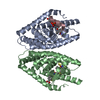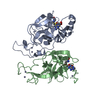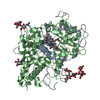Entry Database : PDB / ID : 3ipqTitle X-ray structure of GW3965 synthetic agonist bound to the LXR-alpha Nuclear receptor coactivator 1 Oxysterols receptor LXR-alpha Keywords / / / / / / / / / / / / / / / / / / / / Function / homology Function Domain/homology Component
/ / / / / / / / / / / / / / / / / / / / / / / / / / / / / / / / / / / / / / / / / / / / / / / / / / / / / / / / / / / / / / / / / / / / / / / / / / / / / / / / / / / / / / / / / / / / / / / / / / / / / / / / / / / / / / / / / / / / / / / / / / / / / / / / / / / / / / / / / / / / / / / / / / / / / / / / / / / / Biological species Homo sapiens (human)Method / / / Resolution : 2 Å Authors Fradera, X. / Vu, D. / Nimz, O. / Skene, R. / Hosfield, D. / Wijnands, R. / Cooke, A.J. / Haunso, A. / King, A. / Bennet, D.J. ...Fradera, X. / Vu, D. / Nimz, O. / Skene, R. / Hosfield, D. / Wijnands, R. / Cooke, A.J. / Haunso, A. / King, A. / Bennet, D.J. / McGuire, R. / Uitdehaag, J.C.M. Journal : J.Mol.Biol. / Year : 2010Title : X-ray structures of the LXRalpha LBD in its homodimeric form and implications for heterodimer signaling.Authors : Fradera, X. / Vu, D. / Nimz, O. / Skene, R. / Hosfield, D. / Wynands, R. / Cooke, A.J. / Haunso, A. / King, A. / Bennett, D.J. / McGuire, R. / Uitdehaag, J.C. History Deposition Aug 18, 2009 Deposition site / Processing site Revision 1.0 Jun 2, 2010 Provider / Type Revision 1.1 Jul 13, 2011 Group Revision 1.2 Feb 21, 2024 Group / Database references / Derived calculationsCategory chem_comp_atom / chem_comp_bond ... chem_comp_atom / chem_comp_bond / database_2 / pdbx_struct_special_symmetry / struct_ref_seq_dif / struct_site Item _database_2.pdbx_DOI / _database_2.pdbx_database_accession ... _database_2.pdbx_DOI / _database_2.pdbx_database_accession / _struct_ref_seq_dif.details / _struct_site.pdbx_auth_asym_id / _struct_site.pdbx_auth_comp_id / _struct_site.pdbx_auth_seq_id Revision 1.3 Apr 3, 2024 Group / Category
Show all Show less
 Yorodumi
Yorodumi Open data
Open data Basic information
Basic information Components
Components Keywords
Keywords TRANSCRIPTION /
TRANSCRIPTION /  Nuclear receptor / LXR homodimer / LXR signaling /
Nuclear receptor / LXR homodimer / LXR signaling /  Alternative splicing / DNA-binding / Metal-binding /
Alternative splicing / DNA-binding / Metal-binding /  Nucleus / Polymorphism / Receptor /
Nucleus / Polymorphism / Receptor /  Transcription regulation /
Transcription regulation /  Zinc /
Zinc /  Zinc-finger / Activator /
Zinc-finger / Activator /  Acyltransferase /
Acyltransferase /  Chromosomal rearrangement /
Chromosomal rearrangement /  Isopeptide bond /
Isopeptide bond /  Phosphoprotein /
Phosphoprotein /  Proto-oncogene /
Proto-oncogene /  Transferase / Ubl conjugation
Transferase / Ubl conjugation Function and homology information
Function and homology information cholesterol binding / hypothalamus development / male mating behavior / NR1H2 & NR1H3 regulate gene expression to control bile acid homeostasis / negative regulation of type II interferon-mediated signaling pathway / negative regulation of cholesterol storage / lipid homeostasis / negative regulation of macrophage derived foam cell differentiation /
cholesterol binding / hypothalamus development / male mating behavior / NR1H2 & NR1H3 regulate gene expression to control bile acid homeostasis / negative regulation of type II interferon-mediated signaling pathway / negative regulation of cholesterol storage / lipid homeostasis / negative regulation of macrophage derived foam cell differentiation /  estrous cycle / cellular response to Thyroglobulin triiodothyronine / Synthesis of bile acids and bile salts / positive regulation of cholesterol efflux / Endogenous sterols / Synthesis of bile acids and bile salts via 27-hydroxycholesterol / Synthesis of bile acids and bile salts via 7alpha-hydroxycholesterol / nuclear retinoid X receptor binding / positive regulation of lipid biosynthetic process / response to retinoic acid /
estrous cycle / cellular response to Thyroglobulin triiodothyronine / Synthesis of bile acids and bile salts / positive regulation of cholesterol efflux / Endogenous sterols / Synthesis of bile acids and bile salts via 27-hydroxycholesterol / Synthesis of bile acids and bile salts via 7alpha-hydroxycholesterol / nuclear retinoid X receptor binding / positive regulation of lipid biosynthetic process / response to retinoic acid /  histone acetyltransferase activity / regulation of cellular response to insulin stimulus / Recycling of bile acids and salts /
histone acetyltransferase activity / regulation of cellular response to insulin stimulus / Recycling of bile acids and salts /  histone acetyltransferase / cellular response to hormone stimulus / NR1H3 & NR1H2 regulate gene expression linked to cholesterol transport and efflux / positive regulation of adipose tissue development / peroxisome proliferator activated receptor signaling pathway / RORA activates gene expression / VLDLR internalisation and degradation /
histone acetyltransferase / cellular response to hormone stimulus / NR1H3 & NR1H2 regulate gene expression linked to cholesterol transport and efflux / positive regulation of adipose tissue development / peroxisome proliferator activated receptor signaling pathway / RORA activates gene expression / VLDLR internalisation and degradation /  lactation / positive regulation of protein metabolic process / positive regulation of neuron differentiation / Regulation of lipid metabolism by PPARalpha / hormone-mediated signaling pathway / cerebellum development / BMAL1:CLOCK,NPAS2 activates circadian gene expression / SUMOylation of transcription cofactors / Activation of gene expression by SREBF (SREBP) / nuclear receptor coactivator activity / response to progesterone / cholesterol homeostasis / nuclear estrogen receptor binding /
lactation / positive regulation of protein metabolic process / positive regulation of neuron differentiation / Regulation of lipid metabolism by PPARalpha / hormone-mediated signaling pathway / cerebellum development / BMAL1:CLOCK,NPAS2 activates circadian gene expression / SUMOylation of transcription cofactors / Activation of gene expression by SREBF (SREBP) / nuclear receptor coactivator activity / response to progesterone / cholesterol homeostasis / nuclear estrogen receptor binding /  nuclear receptor binding / hippocampus development / negative regulation of proteolysis / RNA polymerase II transcription regulatory region sequence-specific DNA binding / Heme signaling / SUMOylation of intracellular receptors / mRNA transcription by RNA polymerase II / Transcriptional activation of mitochondrial biogenesis /
nuclear receptor binding / hippocampus development / negative regulation of proteolysis / RNA polymerase II transcription regulatory region sequence-specific DNA binding / Heme signaling / SUMOylation of intracellular receptors / mRNA transcription by RNA polymerase II / Transcriptional activation of mitochondrial biogenesis /  regulation of circadian rhythm / PPARA activates gene expression / Cytoprotection by HMOX1 / chromatin DNA binding / cerebral cortex development / negative regulation of inflammatory response / Transcriptional regulation of white adipocyte differentiation / Nuclear Receptor transcription pathway / RNA polymerase II transcription regulator complex / male gonad development /
regulation of circadian rhythm / PPARA activates gene expression / Cytoprotection by HMOX1 / chromatin DNA binding / cerebral cortex development / negative regulation of inflammatory response / Transcriptional regulation of white adipocyte differentiation / Nuclear Receptor transcription pathway / RNA polymerase II transcription regulator complex / male gonad development /  nuclear receptor activity /
nuclear receptor activity /  Circadian Clock / response to estradiol / HATs acetylate histones / DNA-binding transcription activator activity, RNA polymerase II-specific / Estrogen-dependent gene expression / cellular response to lipopolysaccharide /
Circadian Clock / response to estradiol / HATs acetylate histones / DNA-binding transcription activator activity, RNA polymerase II-specific / Estrogen-dependent gene expression / cellular response to lipopolysaccharide /  transcription regulator complex /
transcription regulator complex /  cell differentiation /
cell differentiation /  transcription coactivator activity /
transcription coactivator activity /  receptor complex / transcription cis-regulatory region binding /
receptor complex / transcription cis-regulatory region binding /  protein dimerization activity / DNA-binding transcription factor activity, RNA polymerase II-specific / positive regulation of apoptotic process
protein dimerization activity / DNA-binding transcription factor activity, RNA polymerase II-specific / positive regulation of apoptotic process
 Homo sapiens (human)
Homo sapiens (human) X-RAY DIFFRACTION /
X-RAY DIFFRACTION /  SYNCHROTRON /
SYNCHROTRON /  MOLECULAR REPLACEMENT / Resolution: 2 Å
MOLECULAR REPLACEMENT / Resolution: 2 Å  Authors
Authors Citation
Citation Journal: J.Mol.Biol. / Year: 2010
Journal: J.Mol.Biol. / Year: 2010 Structure visualization
Structure visualization Molmil
Molmil Jmol/JSmol
Jmol/JSmol Downloads & links
Downloads & links Download
Download 3ipq.cif.gz
3ipq.cif.gz PDBx/mmCIF format
PDBx/mmCIF format pdb3ipq.ent.gz
pdb3ipq.ent.gz PDB format
PDB format 3ipq.json.gz
3ipq.json.gz PDBx/mmJSON format
PDBx/mmJSON format Other downloads
Other downloads https://data.pdbj.org/pub/pdb/validation_reports/ip/3ipq
https://data.pdbj.org/pub/pdb/validation_reports/ip/3ipq ftp://data.pdbj.org/pub/pdb/validation_reports/ip/3ipq
ftp://data.pdbj.org/pub/pdb/validation_reports/ip/3ipq Links
Links Assembly
Assembly

 Components
Components
 Homo sapiens (human) / Gene: LXRA, NR1H3 / Plasmid: pSX29 / Production host:
Homo sapiens (human) / Gene: LXRA, NR1H3 / Plasmid: pSX29 / Production host: 
 Escherichia coli (E. coli) / Strain (production host): DH10-T1r / References: UniProt: Q13133
Escherichia coli (E. coli) / Strain (production host): DH10-T1r / References: UniProt: Q13133 / NCoA-1 / Steroid receptor coactivator 1 / SRC-1 / RIP160 / Protein Hin-2 / Renal carcinoma antigen NY-REN-52
/ NCoA-1 / Steroid receptor coactivator 1 / SRC-1 / RIP160 / Protein Hin-2 / Renal carcinoma antigen NY-REN-52 histone acetyltransferase
histone acetyltransferase Sulfate
Sulfate Water
Water X-RAY DIFFRACTION / Number of used crystals: 1
X-RAY DIFFRACTION / Number of used crystals: 1  Sample preparation
Sample preparation
 SYNCHROTRON / Site:
SYNCHROTRON / Site:  ESRF
ESRF  / Beamline: ID14-2 / Wavelength: 0.933 Å
/ Beamline: ID14-2 / Wavelength: 0.933 Å : 0.933 Å / Relative weight: 1
: 0.933 Å / Relative weight: 1  Processing
Processing :
:  MOLECULAR REPLACEMENT
MOLECULAR REPLACEMENT Movie
Movie Controller
Controller














 PDBj
PDBj

















